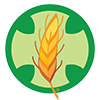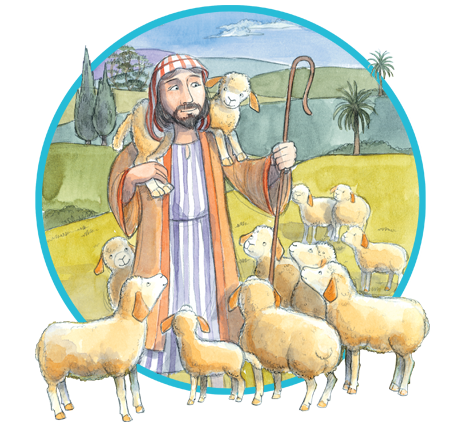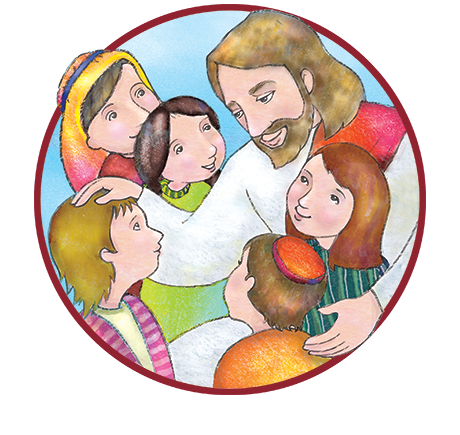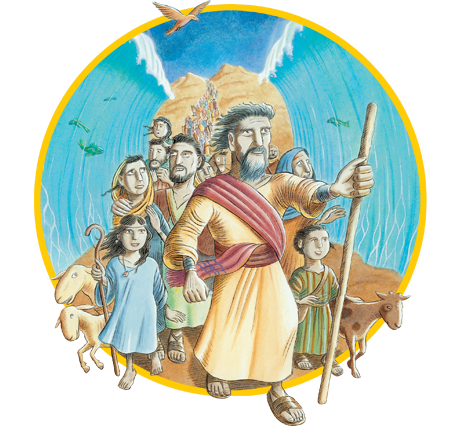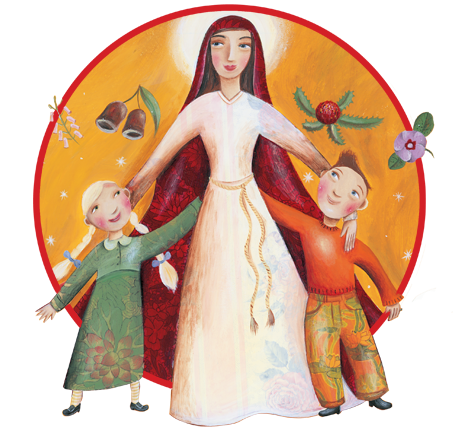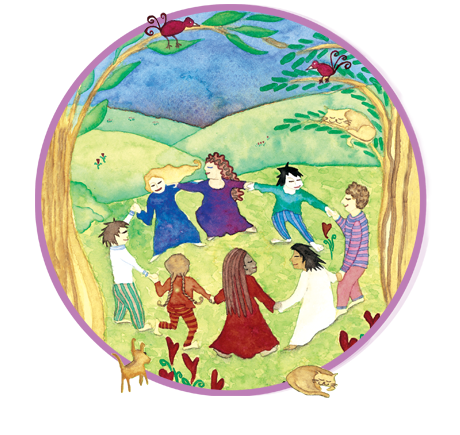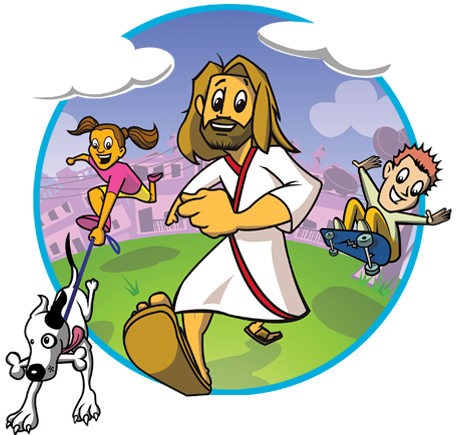To Know, Worship and Love, Prep/Kindergarten
The first three books in the series To Know, Worship and Love, K, 1 and 2, are based on the Catechesis of the Good Shepherd. This method of religious education and formation was first developed in mid twentieth century Italy by women who studied under Maria Montessori. The young child is introduced directly to Jesus Christ in the Gospels and to the liturgical and sacramental life of the Church. The learning process is built around story, play and wonder. Normally a text book is not used for the Catechesis of the Good Shepherd, but in a school context these texts support the interactive process in a sacred learning space, or “atrium”. In the classroom this space is proposed in adapted form in chapter 1, Our Prayer Place.
In chapter 2, The Good Shepherd, and unit 3, Lost and Found, the authors first present Jesus Christ as the Good Shepherd. This is the symbol of Christ that children most easily relate to, across all cultures. Then his saving work for us is presented in the key events of the Paschal Mystery, his death and resurrection: 4. Jesus Washes the Disciples Feet, 5. Take and Eat, 6 From Death to New Life, 7, Jesus is Alive, 8. The Spirit Comes. Chapter 9, Our Wonderful World presents the mystery of creation all around us. The strong Eucharistic emphasis is developed further as he child explores the sacred space of the church building in chapter 10, We Visit the Church. The concrete symbols of worship lead into chapter 11 Together at Mass. Liturgical and sacramental catechesis is essential in the Good Shepherd experience. Young children are fascinated by symbols and readily enter the space and action of liturgy.
Some Old Testament stories that young children can absorb are presented in chapters 12, Our Parents in Faith, on Abraham and Sarah, 13, The Birth of Moses, and 14, God Chooses David. From the first year of school, the young Catholic is thus introduced to the key stories of his or her Judaeo-Christian heritage. Chapters 18, 19 and 20 accompany the season of Advent and Christmas. In the Northern Hemisphere these chapters would be used early in the school year.
The Shape of a Good Shepherd Chapter
Each Chapter begins with a story taken from Scripture or life. This is followed by I Wonder, a key component in the Good Shepherd experience. “Wonder questions” do not require a final reply (closure) but invite the child to wonder at the mystery of God among us in Christ. They draw on the spiritual awareness of the baptised child, on his or her religious imagination and capacity to explore. A Home Activity links the domestic church to learning at school or in a CCD group so that parents may truly be the “first educators” in faith. Prayer is the response of the children as they develop a personal faith relationship with Jesus the Good Shepherd.
Scripture references to be read to the children are provided on pp, 154-166
KWL Big Books and Posters are available to accompany some chapters in this text.
Bishop Peter Elliott, General Editor
To Know, Worship and Love, Grade 1
Continuing the methods and emphasis of the Catechesis of the Good Shepherd, established in Prep/Kindergarten, chapter 1, God’s Book, The Bible presents the Scriptures as God’s stories for us. In chapter 2, Together at Mass children are led into the liturgy. This would need to accompany the actual celebration of Mass for the children or their participation in Sunday Mass.
The Seasons of Lent and Easter run through chapters 4 to 9, filling out in more detail what was presented basically in the first book. So the young child is gradually led into the wonder and reality of the Paschal Mystery.
In chapter 10. Jesus the Good Shepherd is presented relating to the children he loves, the children who experience his catechesis. This leads into the Sacrament of Baptism. In this book there is a specific emphasis on Baptism, centred around Chapter 11, rather than on the Eucharist. If children learn to relate personally to Jesus Christ, so they should learn how to relate to his Blessed Mother, hence Chapter 12, Mary Our Mother. Marian themes are found at all levels of To Know, Worship and Love.
Chapters 13 to 15 develop some of the key “Parables of the Kingdom”. The concrete fabric and message of Christ’s parables is a major part of the Catechesis of the Good Shepherd. But the theme of creation is introduced once more in chapter 17, In the Beginning. The original art work specially commissioned for this chapter is available as KWL posters. Chapter 18 on forgiveness is remote preparation for the Sacrament of Penance and Reconciliation. Gratitude is emphasised in Only One Said Thank You, chapter 19. The miracle of the Feeding of the Five Thousand is the theme of chapter 20. Miracles are an important way of forming sound Christology in the early years.
St Matthew’s approach to the Birth of Christ is found in the final chapter, Jesus is Born. In the Northern Hemisphere this chapter would be used early in the school year.
The Shape of a Good Shepherd Chapter
Each Chapter begins with a story taken from Scripture or life. This is followed by I Wonder, a key component in the Good Shepherd experience. “Wonder questions” do not require a final reply (closure) but invite the child to wonder at the mystery of God among us in Christ. They draw on the spiritual awareness of the baptised child, on his or her religious imagination and capacity to explore. A Home Activity links the domestic church to learning at school or in a CCD group so that parents may truly be the “first educators” in faith. Prayer is the response of the children as they develop a personal faith relationship with Jesus the Good Shepherd.
Scripture references to be read to the children are provided on pp, 160-172
Our Prayers, pp. 173-174, provide basic Catholic prayers the child learns by heart.
KWL Big Books and Posters are available to accompany some chapters in this text.
Bishop Peter Elliott, General Editor
To Know, Worship and Love, Grade 2
The striking cover of this book indicates the Old Testament theme that complements the usual Good Shepherd emphasis on the Gospels. Further developing methods based on the Catechesis of the Good Shepherd, this book first helps children deepen their understanding of God in chapter 1, Images of God. The human family and the Church as God’s family are presented in chapters 2 and 3, with selected saints as leading Christians in chapter 4. The life story of St Patrick is set out in chapter 5.
Liturgical catechesis is an essential component in the Catechesis of the Good Shepherd. Teaching the signs and symbols unfolds throughout chapters 6 to 12. Lent and the Paschal Mystery are presented in three moments in chapter 6, with a focus on the blessed ashes and palms, the washing of feet, the veneration of the cross and chapter 7 Jesus is the Light of the World, proclaimed in the lights of the Easter Vigil. The Paschal Mystery in its Old Testament roots, is introduced in chapter 8, God of Freedom – the Exodus event and the role of Moses.
The Sacraments, especially the Eucharist, are the focus of signs and symbols in chapter 9, in preparation for the following year when children usually receive their First Communion after more focused Eucharistic catechesis. First Reconciliation is anticipated in the two parts of chapter 10 built around the Prodigal Son: repentance, welcome and forgiveness. Chapter 11. Feeding the Hungry, also has two moments, moving from Christ feeding multitudes to Christ feeding us with his Body and Blood in the Eucharist. Chapter 12, Pentecost People, may serve either as remote preparation for Confirmation, or as immediate preparation in places where the sacrament is given at this level.
The wonder of God’s Creation, more parables and prayer are found in chapters 13-17
The final chapters 18 and 19, on Advent and Christmas, conclude the book, but would need to be used at an earlier stage in the academic year in the Northern Hemisphere.
The Shape of a Good Shepherd Chapter
Each Chapter begins with a story taken from Scripture or life. This is followed by I Wonder, a key component in the Good Shepherd experience. “Wonder questions” do not require a final reply (closure) but invite the child to wonder at the mystery of God among us in Christ. They draw on the spiritual awareness of the baptised child, on his or her religious imagination and capacity to explore. A Home Activity links the domestic church to learning at school or in a CCD group so that parents may truly be the “first educators” in faith. Prayer is the response of the children as they develop a personal faith relationship with Jesus the Good Shepherd.
Scripture references to be read to the children are provided on pp, 186-202
Our Prayers, pp. 203-204, provide basic Catholic prayers the child learns by heart.
KWL Big Books and Posters are available to accompany some chapters in this text.
Bishop Peter Elliott, General Editor
To Know, Worship and Love, Grade 3
This level marks the transition from the Catechesis of the Good Shepherd to more formal instruction guided by the Catechism of the Catholic Church. This has been based on selecting and integrating what is best in the three predominant methods that have shaped Catholic religious education over the past fifty years: doctrinal, kerygmatic and existential.
The first chapters are on God, Creation, the Human Person and the Family, leading into chapter 4, Jesus Teaches Us How Much He Loves Us. Chapter 5 presents the celebration of the Paschal Mystery, Lent, Holy Week and Easter. Chapter 6 provides the ecclesial context for the Scriptures, The Church Lives the Word of God. The child learns that the Church and the Scriptures are inseparable.
In many dioceses this is the age level when most children make their First Confession and First Holy Communion, hence the clearer catechesis on the Sacraments of Reconciliation and the Eucharist. In chapter 12, Penance and Reconciliation comes under the heading, Forgiveness and Strength Are Gifts of the Lord and, that oft neglected essential, grace is presented in chapter 14, Living in the Life of the Holy Spirit. The Eucharistic liturgy is the theme of chapter 7, with attention to the structure of the Mass, and chapter 11 focuses on the Eucharist, particularly on the Real Presence, transubstantiation and what is required to receive Communion. The way we live the Eucharist is developed in chapters 13-15, with an emphasis on personal prayer in chapter 16, Listening and Responding to God.
In chapter 17, Everlasting Life, the sacraments are presented as preparing the dying for eternal life in God. Prayer for the dead is set out simply. The final chapter, devoted to Advent and Christmas concludes the book, but would need to be used at an earlier stage in the academic year in the Northern Hemisphere.
The Shape of a Chapter
In Books 3 to 6 the Chapters are written to help each child “to know, worship and love”. To Remember sets out doctrinal points taken from the Doctrinal Overview that covers the seven primary/elementary school levels. This should be learnt by heart. An essay sums up the content of the chapter. This is followed by The Word of God, both in Scripture and in Tradition, according to the teaching of the Second Vatican Council, Dei Verbum 10. Our Prayer is the heart of the chapter. Living the Gospel applies the theme to the daily experiences of children. Did You Know? cultivates cognitive skills and Reflecting Together At Home and At School relates parents as the first teachers in the domestic church to the learning process at school or CCD class.
Our Prayers, pp. 148-153, builds on the basic Catholic prayers the child should learn by heart, adding more prayers appropriate to the age group.
Summaries of Christian Teaching, pp. 154-157 is particularly useful for memory work, including the Creeds, the Ten Commandment and Precepts of the Church, the Beatitudes, Virtues and Vices, Church seasons etc.
Bishop Peter Elliott, General Editor
To Know, Worship and Love, Grade 4
Consolidating what has been achieved in the year of the “First Sacraments”, book 4 is written for children aged between 8 and 9. The book opens with catechesis on the Trinity, chapter 1, linked to St Augustine. The work of God in creation is presented in chapter 2, leading to the summit of God’s creation, the human person, chapter 3, We Are God’s Work of Art; the person is body and soul, created in the image of God, the foundation of Christian anthropology. The revelation of God’s love is Jesus Christ, chapter 4, above all in his Paschal Mystery, Lent and Easter, chapters 5 and 6.
The Church is depicted as the parish community in chapter 6, but widened out to present the Universal Church led by the Pope. The Liturgy of the Word in the celebration of Mass is emphasised in chapter 7. This complements chapter 11 and helps children appreciate the Scriptures. The saints as “people of the Spirit” make up chapter 8. Chapter 9, on Our Lady, is introduced by a graphic of the rosary, including the new Luminous Mysteries, authorised by the Servant of God, John Paul II.
“Do this in memory of me”, chapter 11, develops a deeper understanding of the Mass., to reinforce catechesis for the “first Sacraments”. The ways in which Christ is present are set out and the Catholic belief in transubstantiation is presented simply in terms of “change”. Chapter 12, on the sacraments of healing, links forgiveness to healing and reinforces what has been achieved in the previous year. It is assumed that children will have access to the Sacrament of Penance and Reconciliation when this chapter is used. Chapter 13 introduces vocation to the priesthood in the context of Holy Orders.
Eschatology is always part of Christ’s Good News proclaimed by his Church. Chapter 17 presents God’s promise of eternal life beyond death and children are taught to pray for the dead, an area of catechesis that needs to be developed more today. The final chapter, devoted to Advent and Christmas concludes the book, but would need to be used at an earlier stage in the academic year in the Northern Hemisphere.
The Shape of a Chapter
In Books 3 to 6 the chapters are written to help each child “to know, worship and love”. To Remember is doctrinal points taken from the Doctrinal Overview that covers the seven primary/ elementary school levels. This should be learnt by heart. An essay sums up the content of the chapter. This is followed by The Word of God, both in Scripture and in Tradition, according to the teaching of the Second Vatican Council, Dei Verbum 10. Our Prayer is the heart of the chapter. Living the Gospel applies the theme to the daily experiences of children. Did You Know? cultivates cognitive skills and Reflecting Together At Home and At School relates parents as the first teachers in the domestic church to learning at school or CCD class.
Our Prayers, pp. 150-155, builds on the basic Catholic prayers the child should learn by heart, adding more prayers appropriate to the age group.
Summaries of Christian Teaching, pp. 156-159 is particularly useful for memory work, including the Creeds, the Ten Commandment and Precepts of the Church, the Beatitudes, Virtues and Vices, Church seasons etc.
Bishop Peter Elliott, General Editor
To Know, Worship and Love, Grade 5
The key theme in Year 5 is the Theological Virtues: Faith, Hope and Love. The ethical emphasis characterises this year. Chapter 2 is thus broken into three moments for each of the virtues, which are related to the life of a child or 10 or 11. Chapter 3 focuses on Lent and prayer, fasting and giving to the poor. The Seven Sacraments, chapter 4, provides an overview of the sacramental economy, leading to Reconciliation and Healing, chapter 5. Holy Week and Easter are covered in chapters 6 and 7. The Sacrament of Confirmation and the gifts and fruits of the Spirit are presented in chapter 8, The Spirit Alive in Us, for years 5 and 6 are levels when the sacrament may be celebrated in various dioceses.
Post-Pentecost solemnities are reflected in chapters 9, The Holy Trinity, and 10, A Heart to Love, on the Sacred Heart. More textured stories appear under the heading Living the Gospel: an Irish tale The Island of Mysteries and Old Man Grumps, set in the 21st century. Chapter 11, Our Church Community, leads into the first exercise in Church history in the series, on the beginnings of the Church in Australia.
The Sacrament of Holy Orders, chapter 13 is followed by two chapters on the Eucharist, 14 on receiving the Eucharist, and 15 on Eucharistic adoration.
The older child is introduced to pro-life action in contemporary Catholicism in chapter 17, Respect Life. A pro-life theme will be found in subsequent high school books in the series. The need to respect others runs through all the primary texts, and prepares for fidelity and sexual morality in adolescence and later life. This book concludes with a chapter on Our Lady and one on Advent and Christmas.
The text for level 5 is written so it could be used also at level 6, upper primary or elementary education. In some countries these levels are blended.
The Shape of a Chapter
In Books 3 to 6 the chapters are written to help each child “to know, worship and love”. To Remember is doctrinal points taken from the Doctrinal Overview that covers the seven primary/ elementary school levels. This should be learnt by heart. An essay sums up the content of the chapter. This is followed by The Word of God, both in Scripture and in Tradition, according to the teaching of the Second Vatican Council, Dei Verbum 10. Our Prayer is the heart of the chapter. Living the Gospel applies the theme to the daily experiences of children. Did You Know? cultivates cognitive skills and Reflecting Together At Home and At School relates parents as the first teachers in the domestic church to learning at school or CCD class.
Our Prayers, pp. 196-201, builds on the basic Catholic prayers the child should learn by heart, adding more prayers appropriate to the age group.
Summaries of Christian Teaching, pp. 202-205 is particularly useful for memory work, including the Creeds, the Ten Commandment and Precepts of the Church, the Beatitudes, Virtues and Vices, etc. A Map of Palestine at the time of Our Lord appears on p. 207.
Bishop Peter Elliott, General Editor
To Know, Worship and Love, Grade 6
The Church in terms of social solidarity introduces this level, One in Christ Jesus, including a challenging Indigenous Australian story. The Beatitudes and saints who exemplify them, chapter 2, and free will, chapter 3, set the theme of living justly and making good choices. Chapter 4, on Reconciliation, leads into Lent and Holy Week, and the reality of Christ’s bodily Resurrection is proclaimed in chapter 6.
The four “marks of the Church” are explained in chapter 7, One, Holy, Catholic and Apostolic, and the Church is then presented as the People of Pentecost in chapter 8. Chapter 9, on the Lord’s Prayer, is followed by The Word of God, presenting the Scriptures and Tradition as one revealing Word, within the Church.
One in the Spirit, chapter 11, centres around Confirmation as may be appropriate at this level. We Gather to Worship presents the Mass as the Lord’s Sacrifice. The God We Worship, chapter 12, explores the mystery of our God and Monotheism.
Mary is presented as The Faithful Disciple in chapter 13, which is followed by sacramental chapters, on Marriage the Covenant of Love and The Anointing of the Sick. Chapter 17 on the mission of Christians in the world reinforces the justice theme. Chapter 18 on Second Coming of Christ leads into a final chapter on Advent.
Parents, teachers and catechists will note a subtle transition in the styles of the art in these later primary level texts – ranging from symbolic and original commissions, with some photos, to selected classical masterpieces. The Catholic child has a right to cultural catechesis. God is celebrated in all the cultures that are taken up and used by the Holy Spirit within the heritage of the Universal Church.
The text for level 5 is written so it could be used also at level 6, upper primary or elementary education. In some countries these levels are blended.
The Shape of a Chapter
In Books 3 to 6 the chapters are written to help each child “to know, worship and love”. To Remember is doctrinal points taken from the Doctrinal Overview that covers the seven primary/ elementary school levels. This should be learnt by heart. An essay sums up the content of the chapter. This is followed by The Word of God, both in Scripture and in Tradition, according to the teaching of the Second Vatican Council, Dei Verbum 10. Our Prayer is the heart of the chapter. Living the Gospel applies the theme to the daily experiences of children. Did You Know? cultivates cognitive skills and Reflecting Together At Home and At School relates parents as the first teachers in the domestic church to learning at school or CCD class.
Our Prayers, pp. 186-191, builds on the basic Catholic prayers the child should learn by heart, adding more prayers appropriate to the age group.
Summaries of Christian Teaching, pp. 192-195 is particularly useful for memory work, including the Creeds, the Ten Commandment and Precepts of the Church, the Beatitudes, Virtues and Vices. A Map of Palestine at the time of Our Lord appears on p. 197.
Bishop Peter Elliott, General Editor
To Know, Worship and Love, Year 7
The first high school or junior secondary text may be seen as a summary of the preceding seven books, K to 6, as well as an introduction to a more academic study of the Catholic Faith. This book has been found useful as a resource for adults seeking basic instruction in the RCIA and an introduction to the Scriptures.
With age appropriate language, the author, Dr Richard Rymarz, helps students take what he calls “a closer look” at their Faith. This is exemplified in the opening chapter, Exploring the Bible, which begins with an Indigenous Australian theme. Chapters 2 and 3 present the Old Testament and the New Testament. This overview approach then changes to four focused chapters on the Old Testament: What the Old Testament Tells us About God, The Story of Abraham and Joseph and the Story of Moses and the Covenant. Chapter 7, The Historical Books presents the history of Israel: the Kings, the Temple and the Exile.
School and Church Communities, chapter 8, includes an overview and revision of key Catholic beliefs, including devotion to Mary and the saints. Chapter 9, Caring for Creaton, begins with the Genesis creation stories to provide a basis for a Christian understanding of ecology.
Chapter 10, reflects part IV of the Catechism of the Catholic Church, on different forms and styles of prayer, appropriately adapted for the 12 year old, and concludes with timely guidance on how to use the rosary.
Liturgical and sacramental catechesis and religious education needs to be more precise at this stage, when the young person is interested in details. Chapter 11 presents a historical explanation of the Mass, Celebrating the Eucharist. Church history is introduced here and will reappear in the other high school texts. A Closer Look at the Celebration of the Eucharist, chapter 12, focuses on the shape of the liturgy and various liturgical signs and symbols: vessels, vestments, lights etc. which are of interest to young people at this age level. Sacred time unfolds in The Liturgical Year, chapter 13, which is followed by chapters that offer detailed studies of the three major seasons, Advent, Lent and Easter, developing further was taught at primary levels. The Easter ceremonies are explained in chapter 16 and related to the Gospel events and the Paschal Mystery of Christ our Redeemer.
This Year 7 text concludes with two important ethical chapters: 17, on the golden rule and what conscience is, and 18, on sin, formation of conscience and conscientious decision-making. During puberty such moral formation is essential. However, the text for Year 7 does not include anything specific on sexuality. At this stage “clear and delicate” sexual information based on Catholic values should be provided by the parents, prudently supported by the Catholic school or CCD.
The appendices include a short Glossary, two “Time Lines”, Our Prayers and Summaries of Christian Teaching (as in the Primary Texts), and two pages on how to go to confession and how to receive the Eucharist,
Bishop Peter Elliott, General Editor
To Know, Worship and Love, Year 8
A wealth of content is offered in Year 8. Continuing the approach he established in Year 7, Dr Richard Rymarz, in chapter 1 first presents Jesus Christ within his own Jewish culture. Then he provides a series of studies of the Church founded by Christ, underlining the Catholic principle that Jesus Christ is inseparable from the Church.
In chapter 2, People and Ministries in the Church the roles of the faithful are presented, from the Pope and Bishops to parish life. Chapters 3 to 5 offer students a history of the early Church: The First Christians, chapter, 3, The Early Church, chapter 4, including Nero’s persecution. What followed is described in chapter 5, Before Constantine: Snapshot of the Third Century. The “snapshot” method gives a vivid picture of what it was like to live in the first Christian communities, for example deciding what to do with Christians who gave in under persecution. This chapter culminates in the achievement of the first Christian Emperor, Constantine.
Chapter 6, A Closer Look at St Paul: a Christian Hero, takes up the “closer look” approach from Year 7, to lead students into the Apostle’s life, work and writings, above all his goal, to help us to know Jesus Christ.
Experiences of Good and Evil, chapter 7, includes “five ways of striving for goodness”. The positive cultivation of the virtues is the best approach to Christian morality and is found in the Catechism of the Catholic Church, based on the wisdom of St Thomas Aquinas. This lays foundations for later studies in ethics. Catholic Belief about Life after Death, chapter 8, is a thorough study of eschatology, developing what was covered in the primary texts in a way that is appropriate for young teenagers. Teenagers ask many questions today about life beyond this life.
Celebrating Being Catholic is a fascinating chapter, with much detail on the Eastern Churches, the other “lung” with which the Catholic Church breathes. Young people are encouraged to value their Catholic Rites, customs and cultures. East and West.
Liturgical and sacramental catechesis continues in A Closer Look at Catholic Symbols, chapter 10, which vividly presents the signs and symbols of the Faith, to lead into Chapter 11, A Closer Look at Some Sacraments. Three chapters on the Sacraments of Initiation follow: A Closer Look at Baptism, A Closer Look at Confirmation and Eucharistic Signs and Symbols, including the ritual actions at Mass.
Chapters 15, The Influence of Jesus, presents different impressions of Christ in the four Gospels. Chapter 16, The Teachings of Jesus: the Parables, revises work covered at primary levels. Church teaching on social justice is introduced in chapter 17, Living the Christian Life, to be developed later in terms of current issues. The final chapter, In the World: a Snapshot of Catholic Life around the World, expands the students’ awareness of their Faith in Peru, Ukraine, Uganda and Papua New Guinea.
Three detailed “Time Lines” appear as appendices, to help students grasp the shape of biblical time and the history of the Church, in the world and in their own nation.
Bishop Peter Elliott, General Editor
To Know, Worship and Love, Year 9
The author of Book 9, Dr. Kathleen Engebretson, draws on her proven pedagogical skills to provide the mid-teens with an engaging text that begins with a strong scriptural emphasis. The first chapter, The Bible: a Book or a Library, leads into chapter 2, How to Read the Bible with specific studies in chapter 3, Old Testament: Selected Texts. In chapter 4, People Who Cared: the Prophets and Social Justice, students are also able reflect on a contemporary understanding of the prophetic mission
What Do Catholics Believe, continues the work of revision and precision begun in the two previous years. Based on the history of Council of Nicaea and explaining the words of the Nicene Creed, this fifth chapter focuses on the Incarnation, the Trinity and the Church.
Chapter 6 covers key themes in local Church history, The Catholic Church in Australia: Education and Politics. Church history is an important component in all the secondary texts of To Know, Worship and Love. Young Catholics need to know where they come from, and who has gone before them, in order to understand their identity and Christian vocation in the twenty-first century, hence the complementary chapter 7, The Catholic Church in Australia, Looking to the Future.
The mid-teens do not represent a settled phase of life, hence the strategy of religious education which will hold a student’s interest, with some specific goals. In this regard chapter 8, Images of Good and Evil, has particular relevance as it draws on contemporary films and different styles of art. The issue of the media and its misuse can promote a critical Christian “subversion” of the destructive side of the mass media, with all the ethical and spiritual implications.
Chapter 9, Healing and Hope, the Sacrament of Penance and Reconciliation is important at this stage. The four secondary books for Years 7 to 10 include an appendix that sets out exactly “how to go to confession” according to the first rite of reconciliation, together with private prayers when receiving the Eucharist. Healing and Hope, the Sacrament of the Anointing of the Sick, chapter 10 explores the last of the seven sacraments and the meaning and power of Christ’s healing love.
Mary, Mother of God and the Church, Chapter 10, offers scope for a wider study of major elements in Mariology, adding something unusual that interests many young people today, the various Marian apparitions.
Chapter 12, The Ten Commandments and Beatitudes, lays the foundation for themes of ethics and social justice that will be developed more formally in Years 10, 11 and 12,
A useful Glossary of Catholic terms is provided together with the three “Time Lines” and the other Appendices that appeared in the previous years.
Bishop Peter Elliott, General Editor
To Know, Worship and Love, Year 10
The striking and unusual cover is a sample of the creative layout and style of a book that is appropriate for mid-teenagers. The cover depicts the Last Supper set in an Australian shearing shed, with a nuance of a Christmas meal. The Christ figure is both host and leader. The apostles are represented by shearers and farm labourers. The “earthiness” is balanced by a sense of wonder and mystery.
Dr Kathleen Engebretson commences the book with a scriptural basis, in the first chapter The Formation of the Gospels, followed by a focused chapter, The Good News of Mark.
However, Church history is the main area offered in the Year 10 text. Four chapters on major phases of Church history follow, The Reformation and Catholic Reform, chapter 3, traces the course of the Reformation from late medieval times through to the response of the Catholic Church at the Council of Trent, with studies of the Jesuits, and the great mystics, St John of the Cross and St Teresa of Avila. Chapter 4, The Changing Church, covers the history and achievements of three of the great ecumenical Councils of the Church: Chalcedon, Vatican I and, in more detail, Vatican II. Chapter 5, Monasticism, presents Benedictine and Cistercian monastic life not only in the past but as it is practised today. East and West, One Faith in Many Communities provides the historical details that complement work begun in Year 8, and anticipate ecumenism in Years 11 and 12.
Ancient and Indigenous Religions, chapter 7, covers this interesting field in Mesopotamia, Egypt, Greece and Asia, with specific emphasis on the spirituality of Indigenous Australians, a recurring theme in most of these texts.
The Eucharist in the Christian Community continues sacramental and liturgical catechesis, by going back to the Passover roots of the Eucharist, in the past and as celebrated by the Jews today. Then the development of Eucharistic faith, worship and devotion is set out, as this has unfolded across the centuries into the present time.
At this stage of religious education, a stronger emphasis on moral principles and ethical issues is evident, particularly in the last four chapters of the book. Chapter 9, Conscience and Decision Making, deepens the theme in Years 7 and 8. In Right Relationship, chapter 10, focuses on Catholic teaching about sexuality and marriage. Chapter 11. Some Moral Issues for Young People, includes the issues and questions involved in drug abuse and alcohol, and homosexuality.
Finally, in chapter 12, Christian Love and the Kingdom of God, students are offered a spiritual approach to “living justly” in our world today. These ethical and justice themes are pitched at a level that speaks to the needs, doubts, problems and ideals of the mid-adolescent.
Most chapters conclude with suggested prayer. All propose engaging activities leading into research. The same Appendices appear as in the previous secondary text.
Bishop Peter Elliott, General Editor
To Know, Worship and Love, Catholic Studies for Senior Secondary Students, (11/12)
The thirteenth book in the series Catholic Studies for Senior Secondary Students spans the last two years of secondary education or high school, pre-university levels in Australia and many other countries. Most of the content is also appropriate for adult education. Every chapter is cross-referenced with the Compendium of the Catechism of the Catholic Church, which is meant to be used with this text.
Themes selected by a working committee were prepared by invited writers, with the needs of students aged between 16 and 18 in view. At this stage, Christian apologetics is urgently needed, hence a “meat and vegetables” approach to the Christian “basics” in the first three chapters: God, Jesus the Christ, and The Human Person. In chapter 4, How Should we Live?, some themes in Catholic Ethical Thinking for Senior Secondary Students, reappear in a compact way. The chapter concludes with ultimate accountability beyond death – heaven, hell and purgatory.
Chapter 5, Vocation and Life, combines a Christian philosophy of life itself as “vocation”, with the specific vocations: marriage, single life, religious life, priesthood etc. A surprising section is on the heroic vocation of the martyrs, using the White Rose student resistance movement in war-time Munich as an example. This book includes the Appendix found in the text on ethics, When a Catholic Marries, describing the requirements and procedures for a valid sacramental marriage.
After trialling and following a proven curriculum, it was thought best to reserve Catholics and Ecumenism, chapter 7 , and Catholics and World Religions, chapter 8, to these final high school levels. At this stage, teachers can expect a more mature understanding of these complex topics, which are proposed in the light of the teachings of the Second Vatican Council and current directives and guidelines.
The Arts and Religion, chapter 9, includes some unusual material with the vivid use of art that characterizes all these texts. Science and Religion, chapter 10, reminds religious educators that many students to live their faith in the world of science and technology. The positive Catholic attitude to science is reinforced, and the theory of evolution is presented with “intelligent design” to provoke discussion and reflection. A useful web link for the science and religion conversation is www.faith.org.uk
Chapter 11 on the Scriptures is for students who do not take courses specifically devoted to Scriptural study. It counteracts fundamentalism, which students will encounter at university, and affirms the Church’s understanding of God’s Word.
The extensive chapter on spirituality explores various classical ways of praying in the Catholic tradition. This leads into the final chapter, on the Eucharist. In a spiritual way the chapter seeks to confront a reality – that the test of Catholic commitment beyond school years will be regular worship at Mass and an ordered sacramental life. World Youth Day in Sydney 2008 is suggested within the encouraging perspective of Pope Benedict’s call to young people, to know Jesus Christ as Lord and Saviour.
Bishop Peter Elliott, General Editor
A Tour through the Chapters of Catholic Studies
- It seemed obvious to begin Catholic Studies with a chapter on God, and the author skilfully balanced classical Catholic understandings of God derived from natural and supernatural revelation, with the interests and issues students raise. There is an underlying theme of apologetics and the Trinity is presented as the author rightly insisted.
- The second chapter Jesus the Christ covers key areas of Christology: Incarnation, Redemption and Resurrection, with an emphasis on the first and the third themes because of obvious issues in apologetics at this level. Young people ask: Was he really divine? Was he fully human? Did he really rise from the dead? But this is integrated with catechesis, a call to faith, honouring what our existing catechetical traditions maintain, putting the key question: what does Jesus Christ mean to me?
- The Second Vatican Council taught that we understand who we are in the light of Jesus Christ. The third chapter deals with the nature of the human person, Christian anthropology. Obviously it is similar to material in Catholic Ethical Thinking for Senior Secondary Students (KWL 2004), but moves in a spiritual direction, the human need for God, anticipating a later chapter on spirituality.
- An even stronger influence of the parallel text Catholic Ethical Thinking is evident in chapter 4, How should we live. There are three stages in this chapter: conscience and morality, social ethics and justice and finally moral accountability. The last section is where the book presents eschatology, what lies beyond death, the “last things”, directly related to the question of how we live in this world. This is probably the best way to introduce serious reflection about the ultimate destiny of the human person and the reality and meaning of purgatory, hell and heaven.
- Vocation and Life, chapter 5, invites students in their late teens to reflect on the meaning of human existence, the purpose of each life, my life. It is a more mature presentation of a unit that used to be part of the year 10 book, obviously more appropriate towards the end of secondary education. Marriage, religious life, single life, priesthood are all presented in the Christian perspective of the divine call that gives meaning and purpose in life, a direct challenge to post-modern nihilism. A surprise section on the heroic vocation, martyrdom, is presented in the light of the “White Rose” circle of university students who were executed in Munich for resisting Hitler during the Second World War. A film has recently been released about the last days of Sophie Scholl, one of these heroic students.
- Being Catholic Today is a broad chapter presenting a series of details, vignettes and experiences taken from the lives of Catholics in Australia, similar to material in earlier levels but more focussed on adult commitment. A wide range of people make up our community, and again the theme of heroic witness and martyrdom is included in the example of Sr. Irene Mc Cormack, murdered by Communist guerrillas in Peru in 1991. We seek to set up ideals for young Catholics. While the cultural context is Australian, the chapter should have a wider appeal beyond this culture.
- A chapter on ecumenism fills in an obvious gap in the series, To Know Worship and Love, for this essential post-Vatican II theme is not covered in the earlier books. The reason ecumenism has not been included until this book is obvious. The student needs a good background of Catholic faith and a level of maturity to understand the vision, policy and practice of our relations and cooperation with other Christians. This is why the chapter was postponed to the last years of To Know, Worship and Love and the author wisely began the chapter by defining what a Catholic is, thus providing a sound starting point for ecumenism.
- The same applies to the eighth chapter, on comparative religion, which was lifted out of the first Melbourne edition of the Year 10 book, hence included here in a form appropriate for a more mature age level. The latest Church documents on inter-Faith relations and a certain emphasis on Islam make this chapter timely and useful – as long as it does not monopolise a curriculum.
- The Arts and Religion, as one would expect is the most visually challenging of the units of study in the book. It includes many surprises and should evoke much interest and provoke creative teaching and learning. One of the dimensions of God that we see unfolding in the era of Benedict XVI is beauty, a constant theme in St Augustine’s heritage, so dear to the heart of our Pope.
- Science and Religion, counteracts a lingering assumption that often hampers religious education at the high school level, ie. that all our students are studying humanities. That is as naïve as imagining that most of them will not be capitalists when they enter a free-market society! The chapter is written in an open way to provoke research and debate, and to eliminate the mischievous myth about “conflict” between the Church and science. The current evolutionary issue of “Intelligent design” is included, but carefully, to provoke discussion and at least indicate that Darwinian evolutionary theory ought to be open to development, questioning and review. A useful English website is indicated: www.faith.org.uk
- The chapter on the Scriptures may be seen as a revision of work already done over the past 12 years, by students who have used these texts since Kindergarten (the first three books in To Know, Worship and Love are based on The Catechesis of the Good Shepherd). This chapter is meant for those who do not take up technical scriptural studies. A critique of fundamentalism is included in a Catholic perspective, however, the approach to Scripture in Catholic Studies does not veer too far in the opposite, hyper-critical direction, as may be seen in the second chapter of the book on Jesus the Christ. Two significant sections are devoted to women of valour in the Old and New Testaments, with emphasis on the Blessed Virgin Mary, as in all the texts of the series To Know, Worship and Love.
- Spirituality was always going to be an important theme in the final book of To Know, Worship and Love. As young people seek “a spirituality”, as growing movements in the Church and gatherings such as World Youth Day seek to meet their spiritual hungers, it is essential to emphasise classical Catholic spiritualities and prayer in contemporary high school religious education. Chapter 12 thus offers many starting points for prayer, meditation, reflection. It has been written by an experienced spiritual director to be open, to initiate rather than to close. I believe it offers much.
- One surprise is how Catholic Studies ends, not with a chapter on eschatology (covered in chapter 4) but with a final chapter on the Eucharist. When we think about it, this is most appropriate and for many reasons. It will be through the Eucharist or apart from the Eucharist that each student will work out his or her Catholic identity in adulthood. The approach taken is somewhat original, a blend of doctrine, liturgy, life and spirituality. The chapter also points towards World Youth Day, Sydney 2008, in a striking collage of Benedict XVI on page 257.
The appendix When a Catholic Marries appeared in Catholic Ethical Thinking for Senior Secondary Students. It was repeated in the second senior high school book not only because it relates to the chapter on vocation, but also to provide guidance about entering a valid sacramental marriage. For this reason, priests have already welcomed this material. Teachers should ensure students read and discuss the pastoral concerns of the Church in this area, ie. what lies behind the rules. We hope this appendix will be something students can refer to in the years beyond school, which also underlines the need for this resource to be a personally owned text that will be there at home in the years ahead.
Parallel Resources
Like any school text, Catholic Studies does not work on its own. I am not going to enter how it works dynamically in the teaching situation; that is a matter for teachers and religious education coordinators. I will only emphasise how it depends on two concrete resources, which every student should have in hand – and own personally.
Obviously the Bible is required, as at all other levels of Catholic religious education where the Scriptures play a normal part in formation. As to the second resource, I recall some discussion in the early stages of this project as to whether the Catechism of the Catholic Church could be required in conjunction with the final books of To Know, Worship and Love. The question was raised: is it feasible to make the universal adult Catechism a companion resource or is this asking too much of students aged 16 to 18?
Fortunately the final editing of Catholic Studies coincided with the appearance of the simpler, more accessible and convenient mini-catechism, the Compendium of the Catechism of the Catholic Church. Therefore, each chapter of Catholic Studies is cross-referenced with the Compendium. This small, beautifully worded and well presented book should be in the hands of every senior Catholic high school student.
The chapters all include not only suggested work exercises, but websites and some key reference books. Naturally we welcome proposals for other resources, new websites, corrections etc. to include in the next edition of Catholic Studies.
How Catholic Studies was written
The Archdiocese of Melbourne has accomplished something virtually unknown elsewhere in the world. Writing and publishing a sophisticated series of catechetical texts is usually the work of a group of dioceses, an episcopal conference or a private publishing house. Since Cardinal George Pell initiated this project in 1997, the 13 texts of To Know, Worship and Love with teacher resource books etc. have been produced by James Goold House Publications, Melbourne, that is by an archdiocesan publishing house within the Vicariate for Religious Education. The Vicariate worked closely with the Melbourne Catholic Education Office, and later with the Catholic Education Office of the Archdiocese of Sydney and the Offices of other Australian dioceses whose Bishops elected to enter this major project and mandate the texts: Armidale, Lismore and Wollongong. But how was this final senior level text prepared?
A published report was submitted to Archbishop Denis Hart on upper secondary religious education was based on feedback from schools, “best practice” etc. This was prepared by a committee seeking to identify religious education needs for Years 11 and 12. This report guided what kind of books could best conclude the series To Know Worship and Love, drawing on what had been achieved yet breaking new ground. This report led to the publication of two distinct texts, not for each level, 11 and 12, but according to themes that cross both years and with a view to supporting students who chose options that relate to religious education in the Victorian Certificate of Education (VCE), the pre-university standard required in the State of Victoria, Australia.
It is interesting to note that in various States of Australia students may choose religious studies courses as part of their pre-university education certificate. The “separation of Church and State”, while being part of our Constitution, is not interpreted in a rigidly ideological way. At both Federal and State levels, ample government funding is available for independent or “private” schools, which are mainly owned by the Church and other Churches, ecclesial communions and religious bodies.
First it was recognised that a text book on the Scriptures was not needed for the VCE option “Texts and Traditions”, because there are ample resources in this field. However, we responded to the request for a distinct and solid resource on Catholic ethics for those students who take a VCE option on ethics. In due course, Catholic Ethical Thinking for Senior Secondary Students appeared in late 2004. Although Dr. Kath Engebretson prepared this book with the VCE in mind, it has enjoyed a wider market beyond this State, in Australia and beyond. Moreover, it was written as the Archdiocese of Sydney joined the Archdiocese of Melbourne in a joint texts project that included the dioceses of Armidale, Lismore and Wollongong, in New South Wales. At the same time, a working committee of people from Melbourne and Sydney came together to define what essential themes should be included in the second book, envisaged as a “general text” for years 11 and 12, which finally appeared in mid 2006 as Catholic Studies for Senior Secondary Students.
The writing of Catholic Studies with editing and sub-editing took longer than any other volume in the series. I was the editor, with detailed textual editing in the capable hands of Sister Leonie Crotty of the Catholic Education Office, Sydney. Close collaboration between Melbourne and Sydney marked the writing, editing and production process. But what was most significant was the direct involvement of Cardinal George Pell and Archbishop Denis Hart. They examined drafts and made corrections and proposals, in detail. Their “ownership” of the final texts in the series To Know, Worship and Love is not merely notional or symbolic. Both these leaders of the Australian Catholic community are well-versed in the nuances, issues and trends of religious education, sharing a common vision of wanting to offer young Catholics the fullness and richness of our living tradition, in fidelity to the teaching Church.
The wide range of authors is evident, with their different interests and skills applied to specific chapters. As with the ethics book, their names do not appear on the specific chapter or chapters they prepared but they are introduced on the back cover of the book. There was much editing of the authors’ work, and all, including the editor, had to submit themselves to a process of independent editing. But the distinct nature of a senior secondary text for twenty-first century Australian Catholic students and their teachers requires that discipline and rigor. Effective educational methods, clear communication, good style, issues of semantics, humour etc. all had to incorporate in the editing process, no matter how reliable or rich the original draft was. It is a large book, and that meant putting limits on material.
At the same time, the art department led by Mary Ferlin set out, not only to surpass the visual quality of the existing senior text, Catholic Ethical Thinking for Senior Secondary Students, but to meet pedagogical needs and, in a more subtle way to evoke a spiritual response through art. It is obvious that the art and layout covers a wide range, with something for everyone, including some surprises and challenges, and we hope much pedagogical value.
While Catholic Studies, as planned, offers a wide spectrum of themes, this may confront and even intimidate some teachers, especially those who currently prefer to take a narrower course (requiring little faith commitment), for example devoting the whole year to “justice” or comparative religion. The task ahead is to rise above that kind of limited, soft option, approach and in each diocese and school to work out useful curricula to cover what this larger book provides and offers, bearing in mind the needs and creativity of each school and drawing on the best practice and experience of religious education teachers. We hope you find this substantial resource useful!
To Know, Worship and Love, Catholic Ethical Thinking for Senior Secondary Students (11/12)
Catholic Ethical Thinking for Senior Secondary Students is written to span the last two years of secondary education or high school, the pre-university levels in Australia and other countries, age levels 16-18. Dr Kathleen Engebretson wrote this text working with other authors who are skilled in specific fields. Much of the extensive content of this book is also appropriate for adult education and parish discussion circles. Web links are suggested for all chapters.
The first three chapters are foundational, to develop a student’s capacity for “ethical thinking”. The art of ethical thinking analyses defective approaches to ethics that are at work in “post modern” society today, and favours the natural law approach. Authorities in Catholic ethics takes up the meaning of the commandments and the new law of love in Christ’s Gospel, focusing on Jesus Christ and his attitude to people and the supernatural virtues and gifts that form Christians. This is taken in a practical direction in the fifth chapter, The pursuit of happiness, on the Beatitudes, completing what began at Year 6 – what Christian happiness really means, here proposed in an ethical perspective.
Catholic Ethical Thinking for Senior Secondary Students continues an ongoing Christian education in human sexuality in parts of chapter 4, Respect for the body, and more specifically in chapter 6, Marriage and family issues. Inspired by Pope John Paul’s “theology of the body”, this chapter sets all sexuality in the perspective of marriage, including issues such as cohabitation, homosexuality, contraception etc. But chapter 4 also focuses on the immediate moral issues and choices faced by young people at school: alcohol, drugs and eating disorders.
Chapter 7 is the culmination of the pro-life ethic that runs through the other texts in the series, To Know, Worship and Love. The “culture of life” is built on respect for the life of the unborn, and that reverence for the right to life is applied in ethical thinking about embryonic stem-cell research, euthanasia and capital punishment.
Forming a just society, chapter 8, is a more detailed study of the principles of Catholic social teaching such as: solidarity, the preferential option for the poor and subsidiarity. The final chapter, Global peace, development and justice looks at the wider world of the early twenty-first century, particularly peace and the status of just war theory, world poverty and international debt. Three issues relevant in Australia and many other countries conclude the chapter: justice for indigenous people, environmental justice and the rights of refugees.
The first Appendix provides case studies, a practical analytical approach to three ethical issues: research on embryonic stem cells, euthanasia, and cohabitation before marriage. A second Appendix, When a Catholic marries, describes the procedures and requirements for a valid sacramental marriage. Most of the students using this text will marry and need the guidance and support of the Church in their vocation of life and love.
Bishop Peter Elliott, General Editor
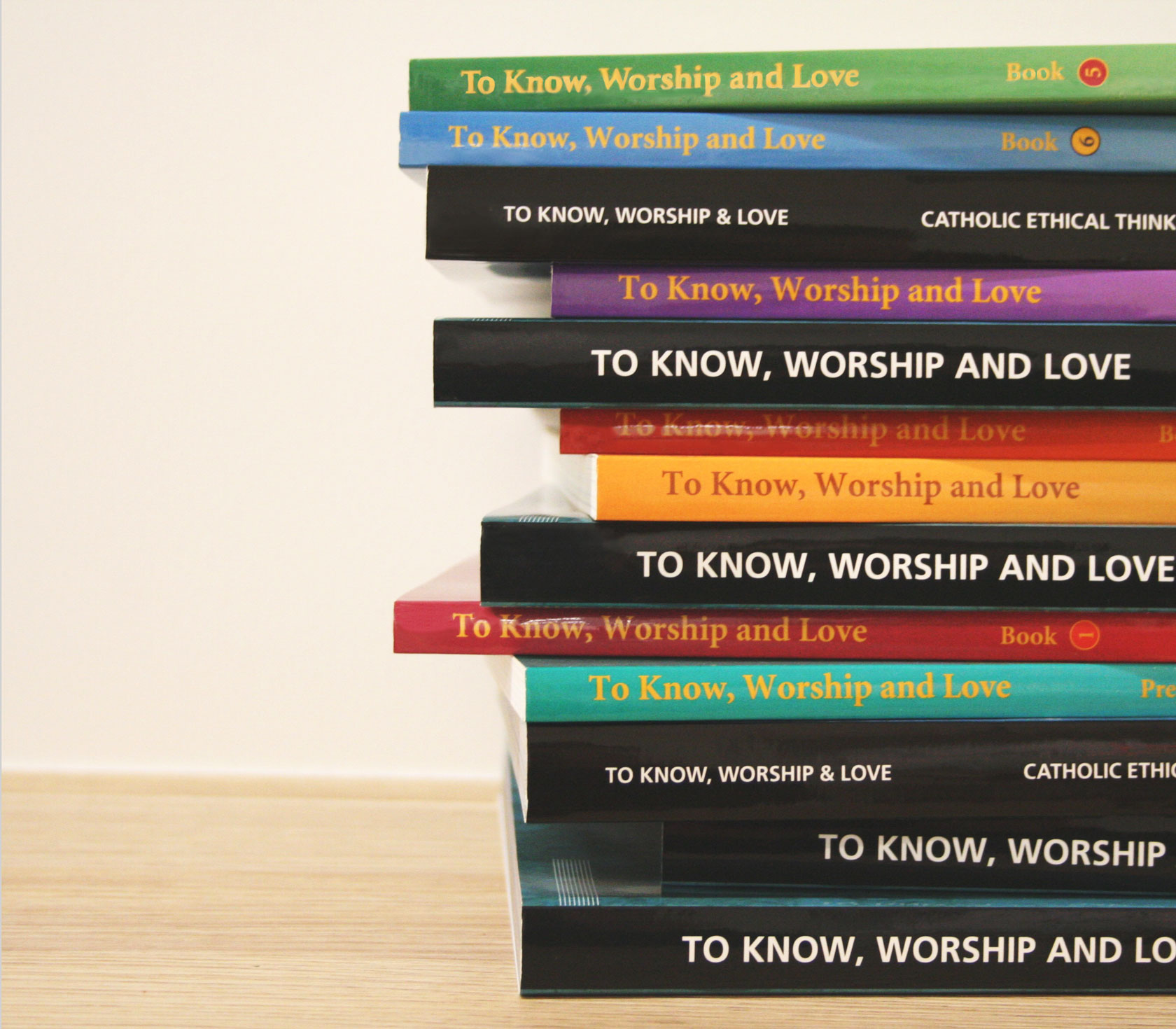
To Know, Worship & Love (KWL) consists of 13 Premium Religious Education Resource Books, ranging from Prep / Kindergarten to Year 12. Recommended by the Holy See, the KWL Suite has received an official ‘recognitio’ from the Congregation for the Clergy in the Vatican. This means it can be used anywhere in the world, while respecting the authority of the local bishop as to whether it is mandated as a course or simply recommended as a resource.
Catering for a wide range of curriculum frameworks, KWL is based on the Catechism of Catholic Church, the Scriptures and liturgy. It has been developed as a synthesis of methods derived from 50 years of Religious Education experience, and is in line with The General Directory of Catechesis, 1997. To Know, Worship and Love (KWL) has the Imprimatur of the Catholic Archdiocese of Melbourne, Australia.
KWL Books for Primary School
KWL Books for Secondary School
KWL Big Books
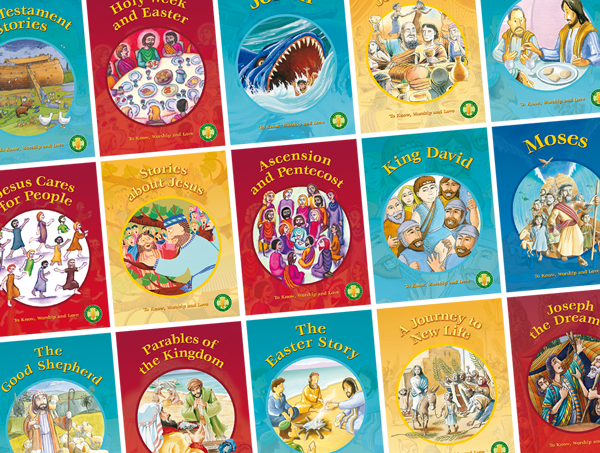
Prices start from $24.00
In addition to the 13 KWL Books, there are Big Books & Posters to complement the Primary component. The Big Books can be used for reading some of the key stories to the junior Primary school levels.
The Big Books are designed so that teachers and catechists can use them as a visual learning resource for groups of students in the class room and also by the children themselves for group and individual research.

KWL Big Books
Prices start from $24.00
In addition to the 13 KWL Books, there are Big Books & Posters to complement the Primary component. The Big Books can be used for reading some of the key stories to the junior Primary school levels.
The Big Books are designed so that teachers and catechists can use them as a visual learning resource for groups of students in the class room and also by the children themselves for group and individual research.
KWL Poster Sets
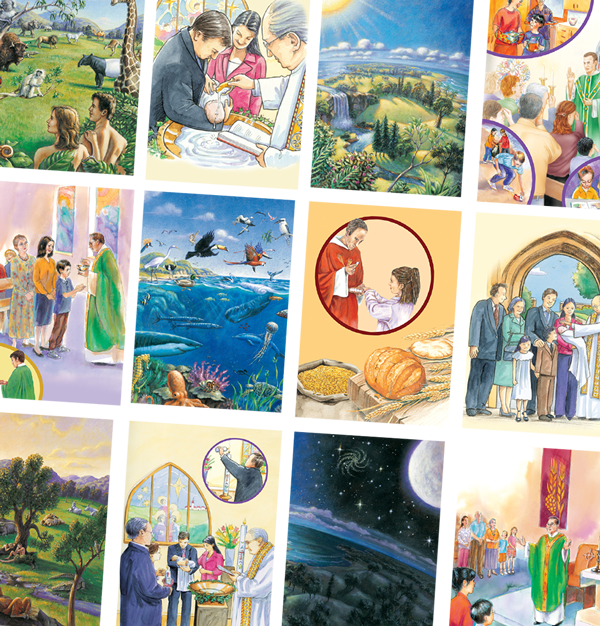
Prices start from $20.00
An addition to the range of available To Know, Worship and Love products are Poster Sets specifically designed for use with Prep/Kindergarten and Year One classes and illustrating selected topics from these two student texts.
The attractive Posters are designed for classroom display and also serve as discussion starters. Currently four Poster Sets are available. These can be ordered on the Big Book/Posters Order Form available on this website.
KWL Poster Sets
Prices start from $20.00
An addition to the range of available To Know, Worship and Love products are Poster Sets specifically designed for use with Prep/Kindergarten and Year One classes and illustrating selected topics from these two student texts.
The attractive Posters are designed for classroom display and also serve as discussion starters. Currently four Poster Sets are available. These can be ordered on the Big Book/Posters Order Form available on this website.

